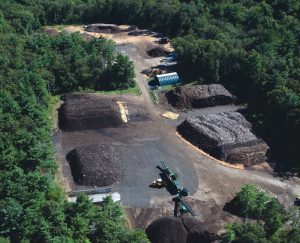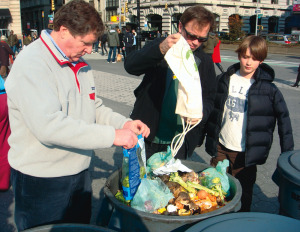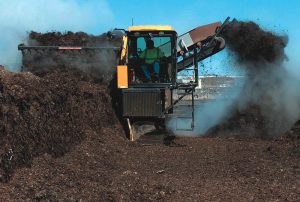State composting, recycling and/or solid waste officials provide perspectives on adoption of curbside collection and composting of source separated residential food scraps. Part I
Rhodes Yepsen
BioCycle October 2014
Residential and commercial food waste collection is becoming more of the norm in much of the U.S., with different drivers based on the region. Both types of programs rely on processing capacity, route density, landfill/incinerator fees, etc., and are assisted by state initiatives that promote diversion from disposal. While commercial programs are typically a contract between businesses or institutions and their haulers, residential programs involve a more intricate municipal process, requiring political will. The first part of BioCycle’s annual survey of residential food waste collection and composting looks at some of the barriers to collection, as well as what states are doing to promote organics diversion. Part II, scheduled for the December 2014 issue of BioCycle, will focus more narrowly on individual municipal programs.

Brick Ends Farm in Hamilton processes residential SS0 from several communities in Massachusetts. Photo by John Sweeney
Northeast
Connecticut: In 2013, the state of Connecticut passed a law requiring large commercial generators of food waste to divert organics to composting or anaerobic digestion (if facilities exist within 20 miles). The law came into effect January 1, 2014, and doesn’t apply to the residential sector. However, one community in the state started curbside residential source separated organics (SSO) collection since then. “Collection won’t be an issue, as there are companies willing and able to provide the service,” says KC Alexander, Connecticut Department of Energy and Environmental Protection (DEEP). As for processing capacity, she doesn’t expect that yard trimmings composting sites, most of which are municipally owned and operated, will modify permits to take food waste, because of increased equipment and labor needs, as well as proximity of these sites to neighbors and waterways.
Maine: While Maine doesn’t have any municipal curbside SSO collection yet, two municipalities offer food scraps drop-off programs, and several businesses offer subscription programs. “We are encouraging entrepreneurs to become engaged,” reports George MacDonald, Maine Department of Environmental Protection. “We are also promoting ‘consolidated collection centers’ at facilities without composting options, for the collection of food scraps and delivery to composters or anaerobic digesters.” As for barriers, MacDonald says that situations vary across the state: “It may be lack of hauler, or lack of site, as well as ‘reluctance of a generator to implement a separation program.’”
Massachusetts: Communities in Massachusetts started piloting residential SSO collection in 2007. In January 2014, Governor Duval Patrick signed into law a commercial food waste disposal ban (for generators producing 1 ton or more per week of food waste) that became effective on October 1, 2014. “The biggest barrier to residential SSO is increased cost to collect a new material stream at the curb,” explains Edmund Coletta, Massachusetts Department of Environmental Protection (MADEP). Haulers are offsetting the cost for SSO collection in some Massachusetts communities by using split-body trucks for weekly cocollection of recycling and food scraps (separate from yard trimmings), and every-other-week trash collection.
MADEP offers annual municipal grants through its Sustainable Materials Recovery Program, which provide assistance to communities that want to collect residential organics or increase recycling. The program’s budget is about $2 million/year. “Municipalities can receive $20/cart purchased, with a maximum award of $100,000,” says Coletta. SSO pilots can receive an additional $10/household for the first 1,000 households to help offset incremental program start-up costs, and be awarded for two years of a pilot (up to $20,000 total). The funds may be used for organics hauling costs, outreach/education, interns or other temporary personnel costs, etc.
New Hampshire: Route density and lack of facilities are reported as the main implementation barriers, especially for many of the state’s smaller towns. “New Hampshire disposal costs are high, but the cost doesn’t seem to be high enough for residents and municipalities to push for food diversion,” reports Douglas Kemp, New Hampshire Department of Environmental Services (NHDES). “We have only a small number of food composters, and no AD facilities for food waste in the state, so this could be an issue for the near future.” To address this, NHDES is drafting new composting rules. “We hope to lessen any regulatory barriers to composting in New Hampshire,” adds Kemp.

General awareness of what composting is and how compost can be used to beautify neighborhoods are significant benefits of residential food scraps drop-off programs, like this one at a New York City Greenmarket.
New York: Besides processing capacity, route density, costs, etc., New York cites general awareness of food waste as a limitation. “One component is lack of appreciation and understanding for the benefits of composting,” notes Gary Feinland, New York State Department of Environmental Conservation (NYDEC). “That is why I think that community composting, like New York City’s Greenmarket drop-off programs, are so important. People become aware of what composting is and how compost can be used to beautify their neighborhoods.” NYDEC is reviewing local materials management plans submitted by planning units throughout the state, providing suggestions on how to improve organics management. “We also have a waste reduction and recycling municipal grants program that can reimburse municipalities for 50 percent of the eligible cost for education or capital expenditures,” continues Feinland. “We don’t anticipate New York to have legislation any time soon to require separation of food scraps from either the commercial or residential sectors.”
Rhode Island: Legislation was passed recently that requires large generators in Rhode Island to divert food waste to composting or anaerobic digestion, which comes into effect January 2016. The major barrier to development of residential SSO in the state has been low tipping costs at the state’s main operating landfill. “We are in the process of amending our composting regulations, which should eventually result in a separate set of regulations geared to very small composting operations to make it less burdensome and more encouraging for small composters to operate,” explains Christopher Shafer, Rhode Island Department of Environmental Management. “This would be especially helpful to such entities as community gardens that do composting, other municipal neighborhood group composting efforts, etc.”
Vermont: The Universal Recycling law (passed in 2012) has a provision for organics that came into effect in July 2014, targeting large commercial generators of food waste first. “The Universal Recycling Law requires all trash haulers to offer collection of food scraps by July 1, 2017 with few exceptions,” explains Josh Kelly, Vermont Agency of Natural Resources. “Due to Vermont’s rural nature, composting in backyards or dropping off food scraps at transfer stations will likely be the easiest and most affordable options for residents.”
Mid-Atlantic
Delaware: The Delaware Department of Natural Resources and Environmental Control (DNREC) has been assisting five coastal communities in southern Delaware to establish a curbside SSO pilot. These communities have existing curbside yard waste collection service, route density and access to a nearby composting facility. Another project is Zero Waste Team Delaware, a group of middle school students. “They received DNREC’s Young Environmentalist Award last year for their efforts in developing a pilot curbside organics collection program in a few neighborhoods of Hockessin,” explains Mindy Anthony, DNREC. “It involves Bottom Up strategies, such as training residents, collecting scientific data from pilots, and creating a website; it also includes Top Down, such as talking to legislators, working with haulers, and spreading awareness throughout Delaware.”
Maryland: A few small residential pilot programs exist in Maryland, and the primary barrier cited to developing programs is processing capacity. “We currently have only one fairly small-scale commercial facility that is accepting food, plus some local government pilot sites,” says Kaley Laleker, Maryland Department of the Environment (MDE). “Some Maryland businesses and institutions have material hauled to Delaware, but that may not be feasible for residential programs.” Laleker adds that MDE is in the process of adopting composting facility regulations in Maryland, which will provide more regulatory certainty. “We expect that after the regulations are final, the number of facilities will increase,” she explains. “The goal is for the regulations to be finalized near the end of 2014.”
In 2012, MDE hosted a Composting Workgroup tasked with developing recommendations. Beyond increasing processing capacity, recommendations centered on promoting compost use and public outreach. As an outcome, this year a law passed requiring the State Highway Administration to develop specifications for compost use in erosion and sediment control and post-construction storm water related to highway projects.
New Jersey: A private hauler has been working with communities to set up residential subscription programs for food scraps. New Jersey Department of Environmental Protection is working on GIS mapping of large organics generators, and has a grant program for towns and schools looking to start food waste recycling initiatives.
Pennsylvania: Pennsylvania has made strides to ease its source separated organics composting regulations, starting with a simple on-farm permit, as well as a modification for municipal yard trimmings facilities to take limited quantities of food scraps.
Midwest
Illinois: There have been a few small residential SSO pilots in Illinois, but only one is still in operation. “Much effort is going into the development of infrastructure to advance food scrap collection and processing in Illinois,” reports David E. Smith, Illinois Energy & Recycling Office. “Since its inception in 2009, the competitive Food Scrap Composting and Revitalization Program (F-SCRAP) has awarded 32 grants totaling nearly $4 million dedicated to bolstering Illinois food scrap collection and processing infrastructure.”
The Illinois Food Scrap Coalition, an ad hoc group, developed a map of composting sites in Illinois that process food scraps and is working with the nonprofit Seven Generations Ahead as part of a grant to identify obstacles and make recommendations on how best to move forward with food scrap recycling (see “State Coalition Advances Food Scraps Diversion,” September 2014). The state is also streamlining the regulatory processes for food scrap composting. “A recent change allows for one-day organics collection events established through application versus permit,” explains Smith. “This will allow, for example, a community to collect pumpkins after Halloween without needing to have the collection site permitted as a transfer station, which previous rules required.”

Several communities in Minnesota have curbside collection of residential SSO, including the City of Hutchinson, which composts in windrows at its CreekSide facility. Photo courtesy of City of Hutchinson
Minnesota: Many cities have yard trimmings collection, as it is illegal to put them in the trash in Minnesota. Several communities around the state have SSO collection. “We’ve heard that transfer capacity is a big barrier,” says Emily Barker, Minnesota Pollution Control Agency (MPCA). “We have composting facilities, but the need for transfer stations is significant.” Minnesota has a tax on solid waste disposal, which recycling and source separated organics are exempt from. “The tax can be a motivator to decrease trash and add things like organics,” notes Barker, adding that revenues from that tax are given back to counties to help fund recycling programs. “The legislature this year increased the funding by $3 million a year going forward (to $17.3 million/year), plus an extra million for 2015. The metro counties (around the Twin Cities) must use at least half of the money for composting.” The legislature also increased the metro counties’ recycling goal to 75 percent by 2030, which will be impossible without organics (the rest of the state stays at a 35 percent goal).
Wisconsin: The state has two small residential pilots, and is working on building infrastructure for food waste composting. “We simplified the state composting facility regulations a couple of years ago to make it easier to license a food waste composting facility, and the state offers free licensing to composting facilities in general,” says Brad Wolbert, Wisconsin Department of Natural Resources. “Since then, we have had a few existing composting facilities add food waste, and maybe one or two new facilities as well, but I’d say the driver was less our simplified regulations and more the increased interest from generators like WalMart and other retailers and others in the food industry.”
South
Kentucky: A small pilot in Lexington that started in 2011, serving a few hundred households, was the first residential food waste collection project in the South. “The number one obstacle to residential SSO is low disposal costs, no doubt about it,” says Bob Bickner, Kentucky Division of Waste Management. “Landfill tipping fees range around $30/ton and in more urban areas maybe as high as $45.” In 2011, Kentucky started collecting fees for composting permits from private entities (counties and cities are exempt), going from no fee up to $3,000, plus an annual renewal fee of $500. “That isn’t going to help matters any,” continues Bickner. “I think we’ve had one composting facility application since then.”
Mississippi: The Mississippi Department of Environmental Quality (MDEQ) is revising its Nonhazardous Solid Waste Management Regulations to streamline the permitting process for composting operations. “During this revision process, we created an interim Pilot Composting Program,” explains Jennifer Milner, MDEQ. “The program was designed to allow new composting facility operators ample time to locate feedstock sources, develop a successful compost recipe, and determine the viability of the facility, while implementing siting and management practices that protect human health and the environment.” Since the program’s inception in 2011, the number of composting facilities in Mississippi has more than doubled. MDEQ also has Solid Waste Assistance Grants (SWAG), offered to local governments for a variety of uses, including costs associated with operating a composting facility.
“Collection is difficult not only with food wastes but also with our traditional curbside recycling,” notes Milner. MDEQ’s Recycling Cooperative Grants Program seeks to address this by awarding funding to regional and local government partnerships where a hub community coordinates with rural “spoke” communities to help establish collection programs for recyclables in the area. At some point that type of program could include food scraps.
North Carolina: Reflecting on trends related to residential food waste collection in North Carolina and other southern states, Scott Mouw of the North Carolina Department of Natural Resources notes: “I think the main issues are certainly cost, and relatedly, the local political will and motivation to fund a program. There may be a general lack of a sense of need and certainly no local precedent here or really even in the region that provides an early adopter example and peer contact.” Landfill tipping fees in North Carolina are around $40/ton, and while composting facilities charge less, it’s often not enough to push a community towards a program, he adds.
South Carolina: The state revised its composting regulation recently to address food scraps, and so far one local government is composting food (no residential material yet). “The primary barrier in South Carolina is the lack of facilities that accept food residuals from any source, not just from curbside programs, but hopefully with our new regulations, that will change,” explains Jana White, South Carolina Department of Health and Environmental Control. “Logistics are also an issue. Curbside recycling programs are rare outside of cities in South Carolina, and many of the city programs are optional and require separate fees. Most rural communities depend on drop-off center recycling.”
Southwest/Central
Arizona: Permitting a composting facility to process food scraps is not difficult in Arizona, according to J. B. Shaw, Arizona Department of Environmental Quality. “It just takes a solid waste facility notification, which is free for under 180 cubic yards per day.” However, a lack of knowledge around potential end markets for compost in Arizona is considered a significant barrier. As far as curbside recycling goes, a recent survey revealed that only 50 out of 112 cities in Arizona have recycling programs.
New Mexico: In Albuquerque, there are residential drop-off sites at farmers markets, but no residential collection. “There was an SSO pilot in Santa Fe a few years back,” reports Tim Gray, New Mexico Environment Department. “A nonprofit tried to start residential pickup of food scraps, but it did not last long. We have low tipping fees at our landfills, so it’s usually more expensive to divert food scraps for composting then it is to send them to the landfill.” New Mexico has three registered food waste composting facilities. Communities can apply for grants to start, pilot, or expand a food scraps composting program from the Recycling and Illegal Dumping Grant Program. “We also teach our three-day Compost Operator Certification Course twice a year and food scrasp composting is always an included topic in that course,” continues Gray. “And we recently received a WalMart grant to develop educational materials to businesses and communities for food scraps management.”
Oklahoma: In Oklahoma City, a nonprofit created a residential food scraps composting program at its community garden. As for the state overall, “we aren’t yet in a position to even consider hurdles to curbside composting as we don’t have facilities that are equipped or willing to take the material,” notes Kelly Dillow, Oklahoma Department of Environmental Quality (DEQ). “We do have grants through DEQ to encourage recycling, and those could include equipment for composting.”
Texas: The most robust pilot for collection of residential food waste in Texas is taking place in Austin, which will be described in more detail in Part II of this survey report. Another collection pilot is taking place in San Antonio.
West
California: There are dozens of residential and commercial food waste composting programs in California, although the state still lacks adequate processing capacity for all of the organics generated. More specifically, the existing infrastructure is not equally distributed, leaving large metropolitan areas like Los Angeles vastly underserved. Of the 414 municipal jurisdictions reporting to the state, 51 percent offer curbside yard trimmings collection. However, only 10 percent offer curbside food scraps collection. “These programs are less common in California’s many rural communities, where lot sizes are large, residences are far apart, and distances to facilities can be enormous,” explains Diana Rivera, CalRecycle. More capacity should be forthcoming. “The Fiscal Year 2014/15 Governor’s budget included $25 million from the Greenhouse Gas reduction fund to provide incentives for capital investments in composting/anaerobic digestion infrastructure and recycling manufacturing facilities,” adds Rivera. In late September, Gov. Brown also signed several landmark pieces of legislation that will significantly advance organics diversion (see BioCycle World in this issue).
Nevada: The largest municipalities in the state are switching to single-stream recycling, and Nevada’s recycling goal of 25 percent has been met over the past three years — without much coming from the organic waste stream. “Curbside organics collection is not even on the radar yet,” notes Nicole Goehring, Nevada Division of Environmental Protection. “Low disposal cost is definitely a barrier. Additionally, the two landfills that receive the bulk of Nevada’s MSW have invested in methane collection systems to generate power, so they want organic material.”
Hawaii: No municipalities in Hawaii offer curbside food scraps collection. “On Oahu, there was discussion about food waste curbside collection, but that project was cancelled,” says Lene Ichinotsubo, Hawaii Department of Health. “It was to be done in conjunction with biosolids composting, but the city opted to send its biosolids to their waste-to-energy facility.” As for conventional recycling and trash, Ichinotsubo notes that not all counties have curbside refuse collection (relying instead on drop-off locations). Backyard composting is promoted.
Pacific Northwest
Alaska: “I do not know of any towns in Alaska that have or are looking to implement a curbside or other collection program for food scraps,” says Rebecca Colvin, Alaska Department of Environmental Conservation. “As for barriers to residential composting programs, I would say a lack of existing composting facilities and little interest in creating them.” The same hurdles exist for recyclables, which have to be shipped out of state for recycling. Anchorage only recently began offering curbside recycling in parts of the city. ”However there are drop-off recycling programs in almost all communities, both large and small, and remote ones,” adds Colvin.
Oregon: There are a few residential SSO programs in Oregon — including the large-scale program in Portland (see “City Residents Adapt To (And Like) Food Scraps Diversion,” August 2014) — and other communities are looking at adding food scraps to yard trimmings. “The main reason for slower evolution of new SSO programs is a lack of processing capacity,” says Bob Barrows, Oregon Department of Environmental Quality. “Oregon has had a very successful yard debris composting system for over 30 years … and composters really like the clean yard debris loads.” In other words, yard trimmings facilities are optimized for a simple feedstock and will have to adapt their system to handle postconsumer food waste, which is more complex.
Washington: Washington State leads the Northwest for organics programs, with 92 percent of the population having access to yard trimmings collection. Estimates from previous BioCycle surveys show that about 27 percent of the population has access to curbside food scrap collection, meaning the state has the most dense network anywhere in the U.S.
Conclusions
While this article discusses some of the serious hurdles to the development of residential SSO collection and processing in the U.S., it also highlights the many proactive initiatives underway to overcome the challenges — legislation (disposal bans), regulation (facility permitting; compost purchase specifications); and grant programs. In Part II of the series, individual programs will be profiled, showing the momentum that is slowly but steadily building across the U.S.
Rhodes Yepsen, Marketing Manager for Novamont North America, was formerly an editor at BioCycle. Since 2007, he has conducted the BioCycle nationwide survey, “Residential Food Waste Collection in the U.S.”










